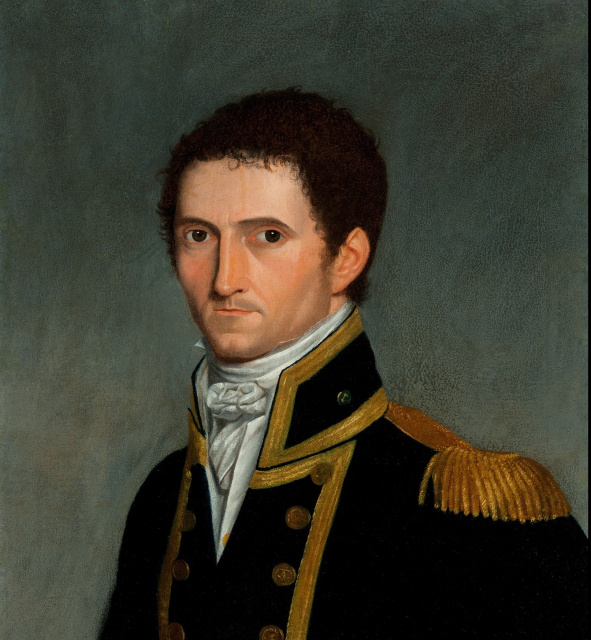* The Investigators Home Page
* The Investigators Background article
* The Investigators sample chapter: Prologue
Matthew Flinders and The Investigators
Anthony Hill
Friday 9 June this year marks the 220th anniversary of Matthew Flinders’ return to Sydney in HMS Investigator, completing the first modern circumnavigation of Terra Australis — the island continent that eventually adopted his preferred name for it: Australia.
It was not the triumphant return Flinders would have wished. His vessel was rotting, about to be condemned. He had a ship full of very sick men: five had died of dysentery on a nightmare sail from Timor, and another four perished within days of reaching the hospital at Dawes Point.
Many others, including the Captain and the botanist Robert Brown, were still suffering from scurvy contracted in the Gulf of Carpentaria in the summer monsoon. And instead of the close survey of the entire coastline Flinders wanted, the north and west coasts had to be passed standing well out to sea in the race against disease and decay to Sydney.
 Even so, Flinders had achieved a remarkable feat. In a very real sense he took up where Captain Cook had left off in Endeavour. He had confirmed the accuracy Cook’s chart, at least to Sandy Point on Fraser Island (K’gari).
Even so, Flinders had achieved a remarkable feat. In a very real sense he took up where Captain Cook had left off in Endeavour. He had confirmed the accuracy Cook’s chart, at least to Sandy Point on Fraser Island (K’gari).
Having the advantage of a chronometer, however, he found there was rather more westing in the land above that, and corrected Cook’s bearings to the point where Flinders left the coast at Broad Sound above modern Rockhampton.
From there he went to Torres Strait. Whereas Cook rounded Cape York and found safe passage to the Arafura Sea from inside the Barrier Reef (which Flinders named), subsequent attempts to navigate the dangerous Strait had ranged from a few weeks to more than two months.
Matthew Flinders on Mauritius by de Chazal
Determined to find a better route, Flinders managed to sail Investigator from Murray Island (Mer) to Cook’s Endeavour Strait in only three days. He discovered an even better route the following year, still known as Flinders Passage.
Above all, Flinders and the Investigators discovered for the Europeans the remaining vast, unknown portions of the continent’s south coast from the head of the Great Australian Bight (which Flinders had also named), to Encounter Bay where he met a rival French expedition under Nicolas Baudin. The discoveries included Kangaroo Island and the two gulfs, proving at last that New Holland and New South Wales were parts of one whole, not separated by any north-south waterway.
This was a point on which Cook was always uncertain – as he was about the existence of what became known as Bass Strait. As he wrote in his journal on 29 January 1777: ‘I need hardly say that [Van Diemen’s Land] is the Southern point of New Holland, which if not a continent is one of the largest islands in the World.’
Flinders, in fact, resolved both questions. In a voyage in the colonial sloop Norfolk during his first sojourn in NSW, Flinders and his friend George Bass had shown that Tasmania is indeed an island separated by the strait the bears Bass’s name.
It was the success of this and two other short voyages on the mainland, and the sheer quality of the charts Flinders produced, that persuaded the Admiralty to fit out Investigator – giving him command to survey the entire coastline of the continent. In this, Flinders had the backing of Sir Joseph Banks, Cook’s voyaging companion on Endeavour, President of the Royal Society, and patron of all things to do with Australasia
Like Endeavour, too, Banks selected the artists and scientists to sail with Investigator (he had a great eye for spotting talented people). He even gave a set of Encyclopaedia Britannica to Flinders to carry on the voyage: it sold at Christie’s in 2021 for some $630,000. At the same sale, a set of Hawkesworth’s voyages, including the Endeavour volume annotated by Flinders during the voyage sold for nearly $750,000 and has been donated by a benefactor the National Archives of Australia.
It was all this that inspired me to write my historical novel The Investigators as a companion book to the earlier Captain Cook’s Apprentice. Like that work, it is also told from the point of view of a young midshipman aboard – in this case Flinders' cousin, John Franklin, then 15, who in later life became Sir John Franklin, lieutenant-governor of Van Diemen’s Land, and one of the most famous explorers of the 19th century. The entire loss of his expedition when discovering the Northwest Passage 1847–48, still fascinates researchers. He always said the Investigator voyage lit the fire of his own ambition for exploration.
Incidentally, Franklin began the first stage of his distinguished naval career at Copenhagen under Nelson, and finished it at Trafalgar – which explains the warship on the cover of The Investigators.
The Investigators is a story of triumph, with the outline map of Australia virtually completed. Disaster, when the crew were shipwrecked of the barrier reef and spent nearly two months cast away literally on a desert island. Tragedy when Flinders was arrested as a spy by the French and held prisoner-of-war on Mauritius six and a half years, allowing his rivals to publish first. Throughout, it is suffused by the sad love story of Matthew and his wife Ann, forced to separate because the Admiralty refused to allow her to sail with her husband.
It’s a great seafaring tale, and one I think that needs retelling for every generation of readers interested in the history of Australian exploration and the making of the modern nation.
Picture Credit: Matthew Flinders by de Chazel, Wikipedia Commons